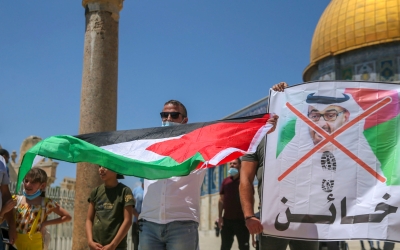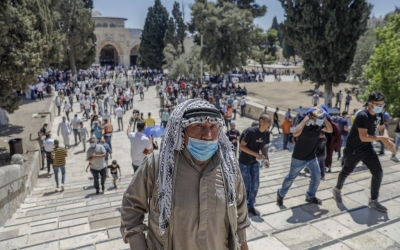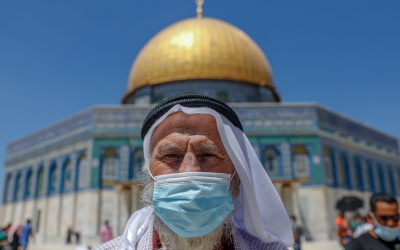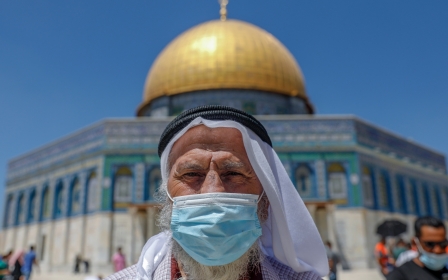How the UAE-Israel deal seeks to impose a 'fait accompli' in Jerusalem

While the normalisation agreement between Israel and the United Arab Emirates is seen by many as a historic peace deal between the two countries, analysts in Jerusalem say it will bring “everything but peace to the region”.
A report by Terrestrial Jerusalem, an Israeli organisation that tracks developments in Jerusalem that could impact political processes or spark violence, says that the phrasing of an initial joint statement between Israel and the UAE raised fears of restrictions to Muslims’ rights to pray at the Al-Aqsa Mosque compound, known to Israelis as the Temple Mount, while legitimising Jewish prayers there, in violation of a longstanding agreement.
The report looked at a joint statement by the US President Donald Trump, Abu Dhabi Crown Prince Mohammed bin Zayed, and the Israeli Prime Minister Benjamin Netanyahu on 13 August, which said that "all Muslims who come in peace may visit and pray at the Al-Aqsa Mosque, and Jerusalem's other holy sites should remain open for peaceful worshippers of all faiths".
The ambiguous phrasing led Terrestrial Jerusalem to say that while the statement was most likely trying to convey a major breakthrough whereby Muslims would be allowed to pray at Al-Aqsa, while the status quo at Haram al-Sharif - another Arabic term for the compound - is being maintained, “the truth is precisely the opposite”.
“The joint statement makes the agreement serve as a cover of legitimacy and an approval from an Arab Muslim country to limit the [definition] of the Al-Aqsa Mosque to the al-Qibli prayer hall, and to consider the remaining 93 percent of the mosque’s space a different area,” Ziyad Ibhais, a researcher on Jerusalem affairs, told Middle East Eye. “This would allow Jewish rituals inside the compound of the Al-Aqsa Mosque."
Ibhaisi added that the US administration considers the issue of the Al-Aqsa Mosque a “central element of the UAE-Israel agreement”.
A rhetorical trick
Jewish tradition has it that the Haram al-Sharif was built where the First and Second Jewish Temples once stood, with some far-right Israeli figures openly advocating for the destruction of Al-Aqsa so a Third Temple can be built in its place.
As such, the religious site has long been the focus of tensions between Israelis and Palestinians.
However, neighbouring Jordan remains the custodian of Christian and Muslim holy sites in occupied East Jerusalem. The status quo agreement recognised by Israel and the Palestinian Authority (PA) states that while non-Muslims are allowed to enter the Al-Aqsa Mosque compound, they cannot worship or pray in Haram al-Sharif.
According to Ibhaisi, the use of the term “Al-Aqsa Mosque” by the US administration is an “adoption of an Israeli trick of terminology” to define Al-Aqsa solely as the al-Qibli prayer hall, instead of encompassing the 35.5 acres of the Haram al-Sharif.
“This is something the [Israeli] occupation has been enforcing by calling the Al-Aqsa compound the Temple Mount, and considering its squares as public municipal squares not recognised as an integral part of the mosque,” he said.
“If we put the two texts of the normalisation announcement and the deal of the century together, it’s not hard to understand what they mean by saying that Muslims will be praying [only] in the al-Qibli chapel with the lead dome,” Ibhaisi continued.
“Meanwhile, Jews and Zionist Christians will be able to pray in all the Al-Aqsa compound, and the agreement with the UAE will serve as an Arab and Islamic cover for this arrangement.”
Ibhaisi argued that the UAE-Israel agreement cannot put an end to Israel’s violations of Palestinian rights, but will instead mark a “new phase of Judaising the Al-Aqsa Mosque and turning it into a synagogue”.
Long prelude
Incursions of Jewish-Israeli settlers in the Al-Aqsa compound first started in the 1980s. While they were initially limited to only a few days a year, they escalated following an Israeli judicial ruling in 2003 arguing that such incursions were merely an "entry of Israeli citizens to a part of their land".
The ruling was a turning point in the work of Israeli police. Once tasked with preventing Jews from entering the Al-Aqsa compound except for a few days during the year, Israeli forces were now protecting and securing groups storming the compound.
According to Ibhaisi, the Israeli government first attempted to impose a complete temporal division of the Al-Aqsa Mosque during religious holidays in September 2015, when Muslims were prevented from entering the Al-Aqsa compound during the Jewish New Year and Sukkot, the Jewish Feast of Tabernacles.
As some extremist Jewish groups currently call for the ritual blowing of the shofar in the Al-Aqsa compound on 19 and 20 September during the celebrations of the Hebrew New Year, and offering sacrifices in October, the UAE-Israel deal seems to be an opportunity for Israeli authorities to impose Jewish rituals in the Al-Aqsa.
Rewarding agreement
Former PA minister of Jerusalem affairs Khaled Abu Arafa told MEE that Israel’s agreement with the UAE could reinforce the division of the Al-Aqsa Mosque and seek to “tempt the UAE” into becoming the custodian of the holy sites in Jerusalem instead of Jordan.
“Israel has its own agenda regarding its agreement with the UAE,” he said. “It will not be satisfied with just a public relations agreement, but will make sure not to spare any effort and to use every line in the agreement to impose a fait accompli at the expense of Palestinians in general, and Jerusalemites in particular.”
Arafa said that similar agreements with Arab leaders - including the Camp David agreement with Egypt in 1977, the Oslo Accords with Palestinian leadership in 1993, and the Wadi Araba agreement with Jordan in 1994 - all ended up being detrimental to rights and livelihoods of Palestinians.
“Israel is reaping the fruits of its relentless efforts since 2010 to change the status of the Al-Aqsa Mosque, taking advantage of the improvement in relations and security coordination with Jordan,” the former Palestinian minister continued.
‘Using the UAE’
Khaled Zabarqa, a Palestinian lawyer specialised in the affairs of Jerusalem and Al-Aqsa, concurred.
'Israel is using the UAE to mislead Arab and Palestinian public opinion'
- Khaled Zabarqa, Palestinian lawyer
“Israel used the UAE as a tool to impose its policies in Jerusalem and the Al-Aqsa Mosque for years, not just since the latest agreement,” he said.
“Two years ago, the Emirati regime tried to buy a property adjacent to the Al-Aqsa Mosque, but the sale process was exposed and cancelled.”
According to Zabarqa, organisations linked to the Emirati authorities in Jerusalem used to take advantage of the fact that Jerusalemites felt comfortable dealing with them in order to buy many properties in the city - only to then transfer said properties to Jewish-Israeli settlers with the knowledge of Israeli intelligence.
“Israel is using the UAE to mislead Arab and Palestinian public opinion, convince them in favour of normalisation and persuade them of the legitimacy of Israeli occupation policies in Jerusalem,” he said.
“What we fear now is that the UAE will claim to promote religious tolerance to mislead Arabs, taking advantage of the fact that Arab and Muslim sympathy with the Palestinian cause of Jerusalem is primarily religious,” Zabarqa added.
With the signing ceremony for the UAE-Israel agreement scheduled to take place in the US on 15 September, Ibhais says that the agreement has been a useful cover for Washington, Tel Aviv and Abu Dhabi.
“Trump needs to record achievements in order to enhance his chances of re-election, Netanyahu wants to strengthen his electoral coalition, and the UAE now needs a US-Israeli cover after it has been involved in serious confrontation with all Arab parties aspiring for change,” he said.
“The agreement is an opportunity for the [Israeli] occupation to enhance its chances of achieving its goals.”
Middle East Eye propose une couverture et une analyse indépendantes et incomparables du Moyen-Orient, de l’Afrique du Nord et d’autres régions du monde. Pour en savoir plus sur la reprise de ce contenu et les frais qui s’appliquent, veuillez remplir ce formulaire [en anglais]. Pour en savoir plus sur MEE, cliquez ici [en anglais].







